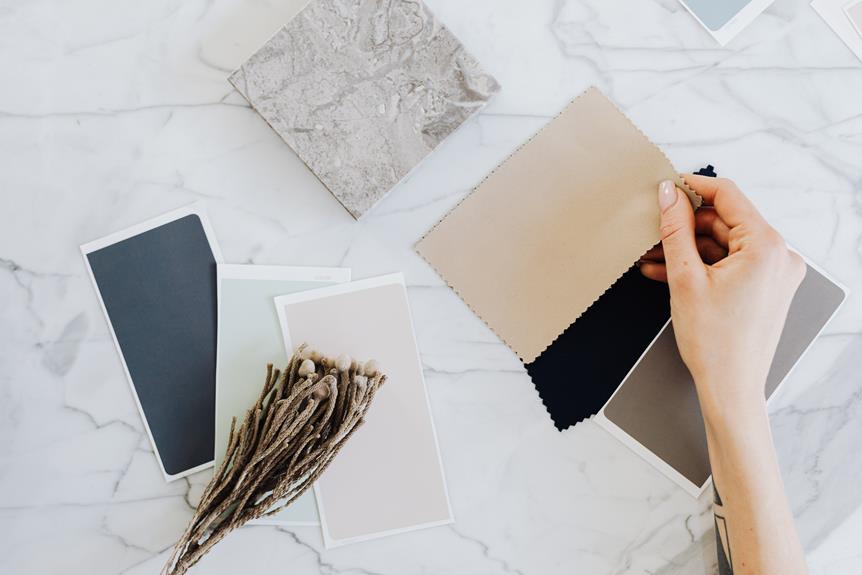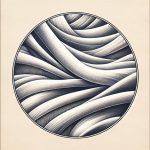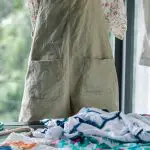When it comes to choosing the right fabric for your project, it's like selecting the perfect tool for the job. Twill and poplin are both versatile options, each with its own unique qualities. Understanding the differences and strengths of these fabrics will empower you to make informed decisions and elevate your craft.
In this article, we'll delve into the characteristics, strengths, weaknesses, and applications of twill and poplin, providing you with the mastery you seek to confidently choose the fabric that best suits your project.
So, let's embark on this fabric exploration and discover which one will help you bring your vision to life.
Key Takeaways
- Twill fabric is durable and structured, making it a good choice for resilient garments and home decor.
- Poplin fabric has a smooth texture and lightweight feel, making it versatile and suitable for a wide range of projects.
- Twill fabric is more prone to wrinkles and less breathable compared to poplin fabric.
- Poplin fabric may not provide as much durability as twill and requires ironing for a crisp look.
Understanding Twill Fabric
If you're considering using twill fabric for your project, it's important to understand its unique weave and characteristics. Twill fabric is distinguished by its diagonal parallel rib pattern, which is created through specific weaving techniques. This weave lends twill fabric a durable and structured nature, making it an excellent choice for garments and home decor that require resilience. Understanding the weaving techniques used to create twill fabric can help you appreciate its strength and versatility.
When it comes to fabric care, twill is relatively low-maintenance. It's advisable to wash twill fabric in cold water to prevent shrinkage and maintain its integrity. Additionally, twill is often used in sustainable fashion due to its durability, which allows for longer garment lifespans, reducing the need for frequent replacements.
Twill fabric can also be found in various finishes, from matte to shiny, allowing for different aesthetics in your projects. Compared to poplin fabric, twill offers a more textured appearance due to its weave, providing a unique visual and tactile appeal. Understanding these characteristics can empower you to make informed decisions when choosing between twill and poplin for your next project.
Characteristics of Poplin Fabric
Exploring the characteristics of poplin fabric reveals its smooth texture and lightweight feel, making it suitable for a variety of projects requiring a polished and comfortable finish.
Poplin is a tightly woven fabric, typically made from cotton or a cotton-polyester blend, offering a soft and lustrous surface. Its plain weave construction lends durability while maintaining breathability, making it ideal for shirts, dresses, and lightweight jackets.
The fabric weight of poplin is often lighter than twill, providing a cool and comfortable wearing experience. Poplin comes in a wide range of color options, from classic whites and blues to vibrant hues, offering versatility for various garment designs.
While poplin is relatively easy to care for, it may wrinkle more than twill, requiring ironing for a crisp look. Additionally, its environmental impact is favorable as it's often made from natural fibers and can be biodegradable.
Poplin's affordability and adaptability make it a popular choice for those seeking a balance between comfort, style, and practicality in their projects.
Strengths of Twill Vs. Poplin
When comparing the strengths of twill versus poplin, you'll find that each fabric offers distinct advantages for different types of projects.
Twill's strength lies in its durability and resistance to wrinkles. The unique diagonal weave of twill creates a strong and sturdy fabric, making it an excellent choice for heavy-duty items like workwear, bags, and upholstery. Its ability to withstand frequent use and washing without losing its shape or integrity makes twill a reliable option for long-lasting projects.
On the other hand, poplin excels in versatility. This lightweight, smooth fabric is incredibly versatile, making it suitable for a wide range of projects. Poplin's fine texture and crisp finish make it ideal for dress shirts, blouses, and dresses, providing a polished and professional look. Additionally, poplin's versatility extends to its ease of manipulation, allowing for intricate detailing and embellishments. Whether you're creating tailored garments or delicate crafts, poplin's adaptability makes it a go-to choice for various sewing projects.
Understanding the specific strengths of twill and poplin empowers you to select the most suitable fabric for your particular project, ensuring optimal results tailored to your needs.
Weaknesses of Twill Vs. Poplin
When choosing between twill and poplin, it's important to consider their weaknesses.
Twill tends to wrinkle more easily than poplin, which may be a drawback for those who prefer low-maintenance fabrics.
Additionally, while twill is known for its durability, it may not be as breathable as poplin, making it less ideal for warmer climates.
Durability: Twill Vs. Poplin
To properly assess the durability of twill versus poplin, you'll need to consider several key factors:
- Weave Structure: Twill fabric's diagonal weave makes it more prone to snagging and tearing compared to the tightly woven poplin.
- Thickness: Poplin's denser weave generally provides better resistance to wear and tear than twill, which is often lighter and more prone to fraying.
- Intended Use: For heavy-duty or high-friction applications, poplin's superior strength is preferable, while twill may suffice for lighter use.
- Care and Maintenance: Twill may require more delicate handling and maintenance to preserve its durability, while poplin tends to be more forgiving.
When considering durability comparison and fabric strength, it's crucial to factor in these elements to make an informed decision for your project's needs.
Breathability: Twill Vs. Poplin
You may notice that twill fabric tends to be less breathable than poplin due to its tighter weave and heavier construction. The denser weave of twill restricts airflow, making it less breathable compared to the lighter and more open weave of poplin. Additionally, the weight of the fabric also plays a significant role in breathability. Twill fabric, being heavier, can feel less airy and breathable against the skin compared to the lighter weight of poplin. Here's a comparison of the breathability and fabric weight differences between twill and poplin:
| Aspect | Twill | Poplin |
|---|---|---|
| Breathability | Less breathable due to tighter weave | More breathable due to open weave |
| Fabric Weight | Heavier construction | Lighter weight construction |
Understanding these differences can help you make an informed decision based on your project's specific needs.
Ease of Ironing: Twill Vs. Poplin
Ironing twill fabric can be more challenging than ironing poplin due to its heavier construction and tighter weave. When it comes to ease of ironing, consider the following:
- Heat Control: Twill fabric requires lower heat settings to avoid damaging the fibers, whereas poplin can withstand higher heat.
- Ironing Techniques: Twill may require more attention to detail, such as ironing inside out or using a pressing cloth to prevent shine, while poplin is more forgiving.
- Fabric Care: Twill fabric often benefits from gentle steaming to release wrinkles, while poplin responds well to traditional ironing.
- Time Investment: Ironing twill may take more time and effort than poplin due to its thicker nature, making it less suitable for quick touch-ups.
Mastering the art of ironing different fabrics involves understanding their unique characteristics and employing suitable techniques for optimal results.
Choosing Between Twill and Poplin
When choosing between twill and poplin for your project, consider the durability of twill. This fabric is known for its strength and resilience, making it a great choice for items that will be subjected to frequent use and wear.
On the other hand, poplin offers a different texture and drape compared to twill. It is generally smoother and lighter, with a more crisp and polished appearance. This makes it a popular choice for garments that require a more formal or elegant look.
These factors – durability, texture, and drape – will play a significant role in determining which fabric is better suited for your specific needs. By understanding these points, you will be able to make an informed decision that aligns with the requirements of your project.
Taking the time to evaluate these characteristics of twill and poplin will ensure that you select the fabric that will best meet your needs and result in a successful outcome for your project.
Durability of Twill
When comparing twill and poplin for your project, it's important to consider the durability of twill fabric. Twill fabric is known for its strength and resilience, making it a great choice for long-lasting projects.
Here are four key factors to consider when evaluating the durability of twill:
- Weave Structure: Twill fabrics have a distinct diagonal weave pattern, which adds strength and durability compared to the simple over-under weave of poplin.
- Resistance to Wrinkles: Twill fabric tends to resist wrinkles better than poplin, maintaining a crisper appearance over time.
- Wear and Tear: The tighter weave of twill makes it more resistant to wear and tear, ensuring your project will withstand frequent use.
- Versatility: Twill's durability makes it suitable for a wide range of projects, from sturdy workwear to long-lasting home textiles.
Understanding the durability of twill fabric will help you make an informed decision for your project.
Texture and Drape Differences
To understand the differences in texture and drape between twill and poplin, assess how each fabric's characteristics will impact your project's overall look and feel.
Twill fabric offers a diagonal weave pattern, resulting in a sturdy, structured texture that drapes well, making it ideal for garments requiring a bit of stiffness.
On the other hand, poplin features a smooth, flat surface with a more pronounced drape, lending itself to a softer, flowing effect.
When considering color options, twill's diagonal weave can create unique visual effects with different hues, while poplin's smooth surface allows for vibrant colors to stand out.
When it comes to draping techniques, twill is suitable for structured designs, while poplin is better for fluid and draped styles.
Understanding these differences will help you make an informed decision for your project.
Applications of Twill and Poplin
For a durable and structured look, consider using twill for your projects, such as pants, jackets, and heavy-duty workwear. Twill's diagonal weave creates a strong and resilient fabric perfect for these applications. On the other hand, poplin's smooth and tightly woven surface makes it ideal for shirts, dresses, and lightweight summer wear.
Here are the best uses for twill and poplin fabrics:
- Twill: Ideal for workwear, uniform pants, and outdoor jackets due to its durability and ability to resist wrinkles and stains.
- Poplin: Perfect for creating lightweight blouses, summer dresses, and formal shirts, thanks to its smooth and crisp finish.
- Twill: Well-suited for creating structured bags, backpacks, and heavy-duty aprons that require a sturdy and long-lasting material.
- Poplin: Great for making children's clothing, linings for jackets, and casual skirts due to its soft texture and comfortable feel.
Understanding the applications of twill and poplin fabrics helps you choose the right fabric for your specific project, ensuring the best results for your desired outcome.
Frequently Asked Questions
Can Twill and Poplin Fabrics Be Used for Outdoor or Athletic Wear?
Yes, both twill and poplin fabrics can be used for outdoor or athletic wear. They offer moisture-wicking properties, durability, and breathability, making them suitable for athletic activities. Additionally, they provide weather resistance, ensuring comfort during outdoor performance.
Are There Any Specific Care Instructions for Maintaining the Quality of Twill and Poplin Fabrics?
For fabric care and quality maintenance, follow specific care instructions for twill and poplin. Consider the fabric's durability for outdoor and athletic wear. Proper care ensures longevity and retains the fabric's integrity.
What Are the Environmental Impacts of Producing Twill and Poplin Fabrics?
When considering the environmental impact, sustainable production is essential for both twill and poplin fabrics. Understanding the production process, material sourcing, and waste management can help you make an informed decision for your project.
Can Twill and Poplin Fabrics Be Easily Dyed or Printed With Patterns?
Yes, both twill and poplin fabrics can be easily dyed using various dyeing techniques. They can also be printed with patterns using different methods, giving you versatility in creating unique and colorful designs for your projects.
Are There Any Specific Historical or Cultural Associations With Twill and Poplin Fabrics?
Historical origins of twill and poplin fabrics vary, contributing to their cultural significance. Twill's association with denim and workwear reflects its rugged history, while poplin's use in high-end fashion signifies its elegance and refinement.
- Your Shopping Guide: Where to Buy the Best Chanderi Sarees in Bhopal - June 25, 2025
- Where to Buy Authentic Chanderi Silk Fabric and Sarees Online - June 25, 2025
- Is Chanderi Cotton a Good Fabric? Pros and Cons - June 25, 2025







